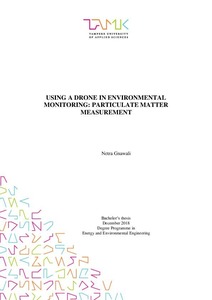Using A Drone in Environmental Monitoring : Particulate Matter Measurement
Gnawali, Netra (2018)
Gnawali, Netra
Tampereen ammattikorkeakoulu
2018
All rights reserved
Julkaisun pysyvä osoite on
https://urn.fi/URN:NBN:fi:amk-2018122022616
https://urn.fi/URN:NBN:fi:amk-2018122022616
Tiivistelmä
Air quality monitoring has been traditionally conducted by ground-based stations, using manned aircrafts or by satellites. Measurement is not always feasible due to complexity of measuring area, moving sources or physical barriers. These reasons encourage introduction of small unmanned aerial vehicles (drone/UAVs) equipped with different sensors in environmental monitoring as they can offer fast performing, comprehensive and cost-effective data acquisition. Moreover, this robotic platform can offer new dimension and research opportunities in many fields. The main objectives of this thesis work were to analyze the scope and challenges of robotic platform (drone), nature of particulate matter at different altitudes and to study the effect of drone propellers on measurement.
Particulate matter (PM) sensors used in this study are Trotec 220 particle counter meter and TSI DustTrak aerosol monitor 8520. Integration of sensor with drone is found very important as measuring device motor can cause electromagnetic interference to the drone GPS signal. This can be minimized or completely excluded by proper selection of sensors and experimental set-up. Measurement was carried out on 1st of November 2018, at Tampere University of Applied Science indoor sports hall.
Results indicated high positive correlation between Trotec and DustTrak measurements. Despite the fact that, they were working under same operating principle (i.e. light scattering), most of the Trotec results are relatively higher than DustTrak results. Which is categorized as systematic error. Average PM mass concentration at ground level is found about 1.5th times bigger than the average mass concentration at the height of 2.66 meter. And most notably, drone propellers effect on the measurement is found significant as results with drone are found about 3 times lower than the results without drone under the same circumstance. Further studies with different experimental set-up’s, proper sensors and repeated measurements are needed to find out more accurate and scientific analysis of propellers effect on measurement.
In conclusion, this was an experimental test measurement which has potential to be extended in other areas such as industrial zones, mining areas, traffic etc. This work explored challenges and potential of drone in environmental monitoring, recognizing and suggesting the future research directions.
Particulate matter (PM) sensors used in this study are Trotec 220 particle counter meter and TSI DustTrak aerosol monitor 8520. Integration of sensor with drone is found very important as measuring device motor can cause electromagnetic interference to the drone GPS signal. This can be minimized or completely excluded by proper selection of sensors and experimental set-up. Measurement was carried out on 1st of November 2018, at Tampere University of Applied Science indoor sports hall.
Results indicated high positive correlation between Trotec and DustTrak measurements. Despite the fact that, they were working under same operating principle (i.e. light scattering), most of the Trotec results are relatively higher than DustTrak results. Which is categorized as systematic error. Average PM mass concentration at ground level is found about 1.5th times bigger than the average mass concentration at the height of 2.66 meter. And most notably, drone propellers effect on the measurement is found significant as results with drone are found about 3 times lower than the results without drone under the same circumstance. Further studies with different experimental set-up’s, proper sensors and repeated measurements are needed to find out more accurate and scientific analysis of propellers effect on measurement.
In conclusion, this was an experimental test measurement which has potential to be extended in other areas such as industrial zones, mining areas, traffic etc. This work explored challenges and potential of drone in environmental monitoring, recognizing and suggesting the future research directions.
